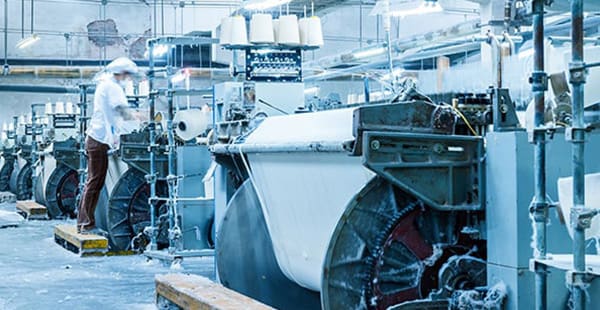01. Asbestos Risk
How Are Textile Mill Workers Exposed to Asbestos?
Before the 1980s, textile mill workers faced a high risk of asbestos exposure. Many mills made items like asbestos blankets, clothing and other fabrics. Companies used asbestos in their textile products because of the mineral’s durability and heat resistance.
Today, asbestos may still be present at older textile factories. Any worker who inhales the mineral’s fibers may be at risk of developing an asbestos disease like mesothelioma.
Workers at textile mills used raw asbestos to make spun materials like yarn. Using raw asbestos fibers put textile workers at a high risk of exposure. Workers also wove these spun materials into fabrics and other textiles.
Starting in the 1970s, public pressure and regulations pushed companies to stop using asbestos. Today, U.S. manufacturers use other materials to make durable and fire-resistant textiles. But older textiles may still contain the mineral.
What Asbestos Products Put Textile Mill Workers at Risk?
Asbestos textile mill workers faced exposure risks when making products like:
- Aprons
- Blankets
- Brake linings
- Cloth
- Fire curtains
- Fireproof clothing
- Furniture padding
- Gloves
- Heat mats
- Insulation
- Ironing board covers
- Oven mitts
- Pipe coverings
- Roofing felts
- Ropes
- Tapes
- Yarns
Equipment and building materials used in textile mills may also have contained asbestos. These were present both at mills making asbestos products and at other types of mills.
Looms and other machines may have had asbestos insulation and other asbestos components. Construction materials subject to high heat, like pipes and gaskets, also commonly contained the mineral. The wear, tear, repair and maintenance of these products can disturb asbestos fibers, causing them to become airborne.
Inhaling asbestos fibers can cause mesothelioma and other serious illnesses. Many companies continue to face consequences for making and selling asbestos textiles. People who develop diseases from exposure may have legal options.
Common Places Textile Mill Workers May Find Asbestos
Asbestos was common both at asbestos textile mills and other types of textile mills. In general, these mills used looms and other machines with asbestos components. The buildings themselves may have been made with asbestos construction materials.
Textile production jobsites where workers may have been exposed to asbestos include:
- Cotton mills
- Fabric mills
- Fiber mills
- Knitting mills
- Thread mills
- Yarn mills
Workers at non-asbestos textile mills may have faced lower exposure risks compared to textile workers who handled raw asbestos. But any level of exposure is dangerous and can lead to diseases like mesothelioma.
Textile Mill Workers and At-Risk Trades
The textile industry encompasses a number of trades that work at the mills. Textile mill-related trades at risk of occupational asbestos exposure include:
- Auto mechanics
- Carpenters
- Construction workers
- Engineers
- Fabricators
- Firefighters
- Industrial workers
- Insulators
- Loom repairers
- Machine operators
- Maintenance workers
- Masons
- Metal workers
- Millwrights
- Oil refinery workers
- Pipefitters
- Power plant workers
- Seamstresses
- Shipbuilders
- Tailors
- Textile mill workers
- Tool and die makers
- Weavers
- Welders
- Veterans
Members of an asbestos textile worker’s household can experience secondary exposure. This happens when a worker accidentally brings asbestos fibers home on their clothes or hair. Many people have developed asbestos diseases from this type of exposure.
02. Mesothelioma Risk
Mesothelioma Risk for Textile Mill Workers
Scientific interest in the link between asbestos disease and asbestos textile work began at least a century ago. In fact, the first medical paper on asbestos illness was written in 1924 about a textile worker. The paper described a woman who developed lung scarring after working in the spinning room of an asbestos factory.
Other studies about asbestos disease among textile workers include:
- A case study of a former asbestos textile factory worker who developed ovarian cancer. According to the authors, the worker’s ovarian cancer was highly related to on-the-job asbestos exposure.
- Another study looked at asbestos textile workers employed between 1950 and 1973. Deaths from mesothelioma and other cancers were significantly higher among the 5,770 workers than in the general population.
- A study of South Carolina textile workers reported similar findings. The workers had at least twice the average risk of dying from lung cancer. In the data, increasing asbestos exposure came with an increasing risk of lung cancer.
Any level of asbestos exposure can cause asbestos diseases. But concentrated and long-term exposures may increase the likelihood of developing these diseases.
Mesothelioma commonly takes 10 – 50 years to develop. This means former textile mill workers may still be at risk of developing asbestos diseases.
Treatment is available for people diagnosed with an asbestos illness. Mesothelioma cancer centers exist throughout the United States.
03. Asbestos Safety
Asbestos Safety for Textile Mill Workers
In the 1970s, U.S. regulators began making rules to protect asbestos workers. For example, the Occupational Safety and Health Administration (OSHA) provides rules and guidelines for asbestos in the workplace.
According to OSHA, any heat-resistant textiles installed before 1981 should be presumed to contain asbestos.
Textile mills and other jobsites that may contain asbestos textiles should hire professionals to inspect any potential asbestos materials. Not hiring abatement professionals may create unnecessary exposure risks.
Exposed workers who develop mesothelioma can speak to an asbestos attorney. An attorney can explain options for compensation and file lawsuits on behalf of their clients.




